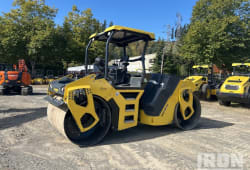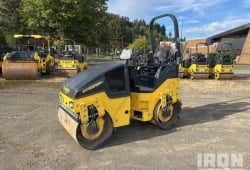Delving Into Mini Excavator Weight Limits for Transportation and Operation
8 Min read
)
October 7, 2023
Mini excavators are versatile machines commonly used in construction and excavation projects. These compact machines have specific weight limits that are critical for both transportation and operation purposes. Exceeding these weight limits can have serious consequences, including safety hazards, equipment damage, and legal issues. This article will delve into the importance of understanding and adhering to mini excavator weight limits to ensure safe and efficient use.
Understanding Mini Excavator Weight Limits
Mini excavators come with specific weight limits determined by their manufacturers, considering factors like design, stability, and capabilities. Adhering to these weight limits is crucial for safe operation. Exceeding these limits can compromise the excavator's stability and control, posing significant safety risks. The machine's structure and balance are finely tuned to operate within these specified weight limits. Overloading the excavator can lead to tip-overs, structural damage, and accidents. Operators and construction professionals need to adhere to these weight limits meticulously to ensure the safe and efficient use of mini excavators, safeguarding both equipment and personnel on the job site.
Navigating Mini Excavator Weight Restrictions
It is important to effectively navigate the mini excavator weight limits for safe and compliant operations. Operators must engage in meticulous planning, considering the total weight of the machine, including attachments and materials. Staying informed about local road regulations and securing permits when necessary is vital to ensure legal compliance during transportation. Adhering to these weight restrictions not only promotes safety but also helps avoid potential fines and legal issues, contributing to the smooth operation of mini excavators. It's a delicate balance between optimizing utility while maintaining safety and regulatory compliance. It is important to consistently implement these practices into operations to ensure the efficient use of mini excavators while upholding safety standards and legal requirements. This approach not only safeguards against accidents and equipment damage but also minimizes the risk of financial penalties and project delays.
The Importance of Knowing Mini Excavator Weight Limits
Understanding the weight capacities of mini excavators is crucial for safe and efficient operations. These weight limits are not arbitrary; they are calculated to maintain stability and prevent accidents. Operators must consult the equipment's manual and follow the manufacturer's guidelines meticulously. Overloading mini excavators can lead to compromised stability, accidents, equipment damage, and potential harm to operators and bystanders. Adhering to weight capacities is most important as it ensures safe and productive work while extending the equipment's lifespan, reducing downtime, and minimizing the risk of costly repairs or replacements. In essence, operators must prioritize and adhere to these weight limits to maintain both safety and operational efficiency in mini excavator use. It's a fundamental aspect of responsible equipment operation, safeguarding against accidents, financial losses, and potential harm to personnel.
Mini Excavator Transportation Weight Limit Considerations
:format(webp))
It is vital for road safety to ensure that mini excavators are transported within weight limits. Beyond the excavator's weight, operators must account for the trailer's weight and any additional accessories or attachments. Properly securing the load on the trailer is essential to prevent shifting during transit, which could lead to accidents. Furthermore, strict adherence to local transportation regulations, including weight restrictions and permit requirements, is essential. Violating these regulations can result in legal troubles, fines, and compromised road safety. By carefully considering all weight-related factors and following transportation guidelines, operators can transport mini excavators safely and in compliance with the law.
Mini Excavator Weight Guidelines
Safety should always be the priority when operating mini excavators. Adhering to weight guidelines is necessary for maintaining stability and minimizing the risk of rollovers and accidents. These guidelines are carefully prepared to ensure safe operation. Regular maintenance checks are equally crucial, as they help preserve optimal performance while keeping the equipment within safe weight limits. Prioritizing safety not only safeguards the operators but also prevents damage to the equipment and reduces the potential for work site incidents. By following these weight guidelines and performing regular maintenance, operators can create a secure and efficient working environment with mini excavators.
Operating Within Mini Excavator Weight Constraints
Operating mini excavators within specified weight limits is not merely a matter of safety; it's also critical for project success. Exceeding these limits can subject the equipment to undue stress, resulting in breakdowns and necessitating costly repairs.
To fully appreciate the importance of these weight restrictions and their direct influence on machine performance, operators should undergo comprehensive training. This education empowers them to make informed decisions that prioritize safety and the equipment's longevity.
By adhering to these constraints, operators not only prolong the lifespan of the equipment but also prevent accidents. This commitment to compliance ensures that excavation projects maintain their efficiency, contributing to a work environment that is both safer and more productive.
Tips for Transporting Mini Excavators Within Legal Limits
When transporting mini excavators within legal limits, operators must consider several key factors. Firstly, it's crucial to verify that the mini excavator's weight aligns with local regulations, including not just the machine itself but also any attached equipment or materials being transported. Additionally, consider the weight of the trailer, as it contributes to the overall load, and ensure it falls within permissible limits. Equally important is the proper distribution of the load on the trailer to maintain stability during transit, reducing the risk of accidents caused by uneven weight distribution.
Moreover, operators should obtain any necessary permits required by local regulations for transporting heavy equipment, especially for oversized loads. Neglecting these permits can lead to legal complications and delays. Lastly, regular inspections of the mini excavator, trailer, and securing mechanisms are essential. This proactive approach helps identify and address any weight-related issues before they result in problems during transportation. By diligently adhering to these tips, operators can safely and efficiently transport mini excavators within the boundaries of the law, minimizing risks and ensuring smooth operations throughout their projects.
Mini Excavator Weight Regulations
Mini excavator weight regulations serve as fundamental guidelines that can significantly impact the planning and execution of construction projects. These regulations, however, vary from one location to another, adding complexity to project management. It is important for operators to possess an in-depth knowledge of the specific weight regulations applicable in their area, including any necessary permits that may be required.
Non-compliance with these weight regulations can have serious consequences. Fines imposed for exceeding weight limits can be financially burdensome, and project delays resulting from regulatory violations can be disruptive and costly.
Moreover, adherence to these regulations extends beyond mere legality; it directly influences project efficiency and safety. Operators who meticulously comply with weight regulations help maintain a smooth workflow on construction sites, contributing to the successful and efficient operation of mini excavators.
Avoiding Fines
Maintaining strict compliance with mini excavator weight limits is essential to avoid costly fines and penalties. Disregarding these weight restrictions not only leads to legal repercussions but also disrupts ongoing projects significantly. Operators must make safety and legality their top priorities by unwaveringly adhering to these weight limits.
By diligently following these weight limits, operators not only reduce the risk of financial penalties but also contribute to a safer work environment. This commitment to compliance ensures that construction activities progress smoothly, minimizing disruptions and potential accidents.
In short, vigilance in adhering to mini excavator weight limits is fundamental. It's a responsible practice that not only protects against financial repercussions but also fosters a secure and efficient work atmosphere, enhancing the overall success of mini excavator operations.
Maximizing Efficiency While Adhering to Mini Excavator Weight Limits
Achieving efficiency while adhering to mini excavator weight limits demands thorough planning and equipment management. The process begins with precise load calculations, ensuring attachments and materials align with weight limits. It's crucial to follow manufacturer guidelines as they offer valuable insights into both optimal performance and safety considerations.
Proper load distribution on the machine is important. It is necessary to balance productivity with weight restrictions to help operators ensure project progress is going smoothly without compromising safety standards. This approach not only enhances productivity but also minimizes the risk of accidents, thus contributing to the successful and safe completion of excavation tasks.
In other words, meticulous planning, adherence to manufacturer guidelines, and efficient load management are essential in striking the delicate balance between productivity and safety within mini excavator weight limits. This approach not only ensures the successful execution of projects but also safeguards against accidents and potential equipment damage.
Final Words
In conclusion, understanding and respecting mini excavator weight limits are essential for safe and efficient operations. Ignoring these limits can result in accidents, damage to equipment, and legal troubles. Prioritizing safety, staying informed about regulations, and following manufacturer guidelines are key to successful mini excavator use. Always remember that safety should be the foremost concern when working with these machines, and compliance with weight limits is a critical part of ensuring a secure and productive work environment.

Rex Walz is Boom & Bucket's Manager of Supplier Relations, bringing over a decade of experience in B2B sales and heavy equipment solutions. With a background spanning government, construction, industrial, and commercial sectors, he has a proven track record of driving growth and building trusted customer relationships. At Boom & Bucket, Rex is passionate about helping partners succeed while advancing the company's mission to create the most trusted marketplace for heavy equipment.














